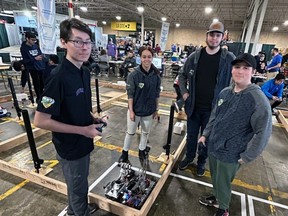Robotic Solutions May Restore Vital Bodily Function for Those That Need it Most
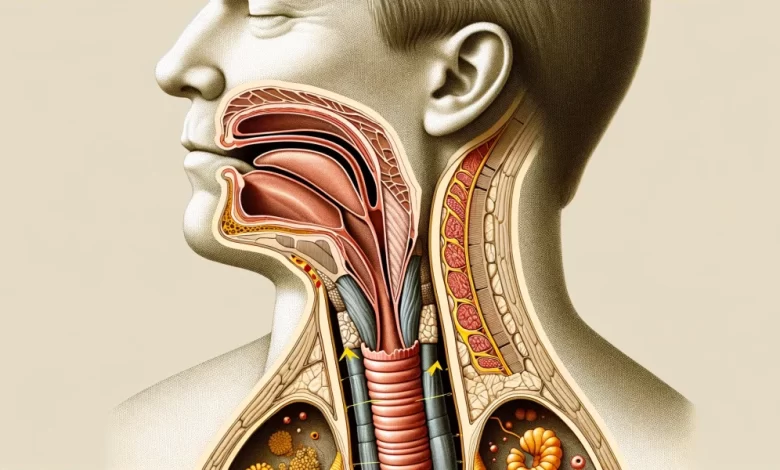
Peristalsis – A Hidden But Important Muscle Mobility
Robotic help to alleviate mobility issues are on the rise, notably exoskeletons. For example, we discussed how it can help Parkinson”s disease patients, and could also give extra mobility to factory and warehouse workers, or even the military like with the Herowear suit developed with Vanderbuilt University.
Source: Herowear
However, not all important movements of the body are from the limbs or back. Peristalsis is the wave-like movement of internal organs like the esophagus (connecting the mouth to the stomach) or the intestine.
This type of movement speeds the transport of fluids and liquids in the body. It is a vital function for digestion and also ensures that food ingested goes into the stomach instead of the lungs.
Peristalsis can be impaired by diseases, notably cancer. The usual treatment is to use a metal tube, which can lead to blockage and other life-threatening issues.
Researchers at the same Vanderbilt University in Nashville, USA, where their colleagues worked on exosuits, have created a soft magnetic robot that could mimic peristalsis instead.
The Rise Of Soft Robotics
Robots are great at manipulating heavy equipment and performing precise manufacturing. But they are much harder to mix with soft and fragile biological tissues.
For these reasons, researchers a looking at ways to create “soft robots”, using plastics, polymers, metal wires, or other more flexible components.
Softer designs should allow for new concepts, more inspired by nature, to be used when building a robot, as we discussed in our article “How Robotics Can Take a Cue From Nature”.
But these systems still suffer from a few limitations:
- They need to be tethered to a power source.
- They are often limited to a few predetermined shapes or movements.
- They are rather heavy.
An idea to remove these limitations is to use magnets instead of rigid metal parts. This removes the need for an external power source and offers more flexibility and diversity of possible shapes and movements. For example, we discussed previously how soft gels could be made magnetic to power such robots.
Robotic Peristalsis
The Vanderbilt University researchers used a flexible magnetic robotic system to recreate the biological undulation movements of peristalsis.
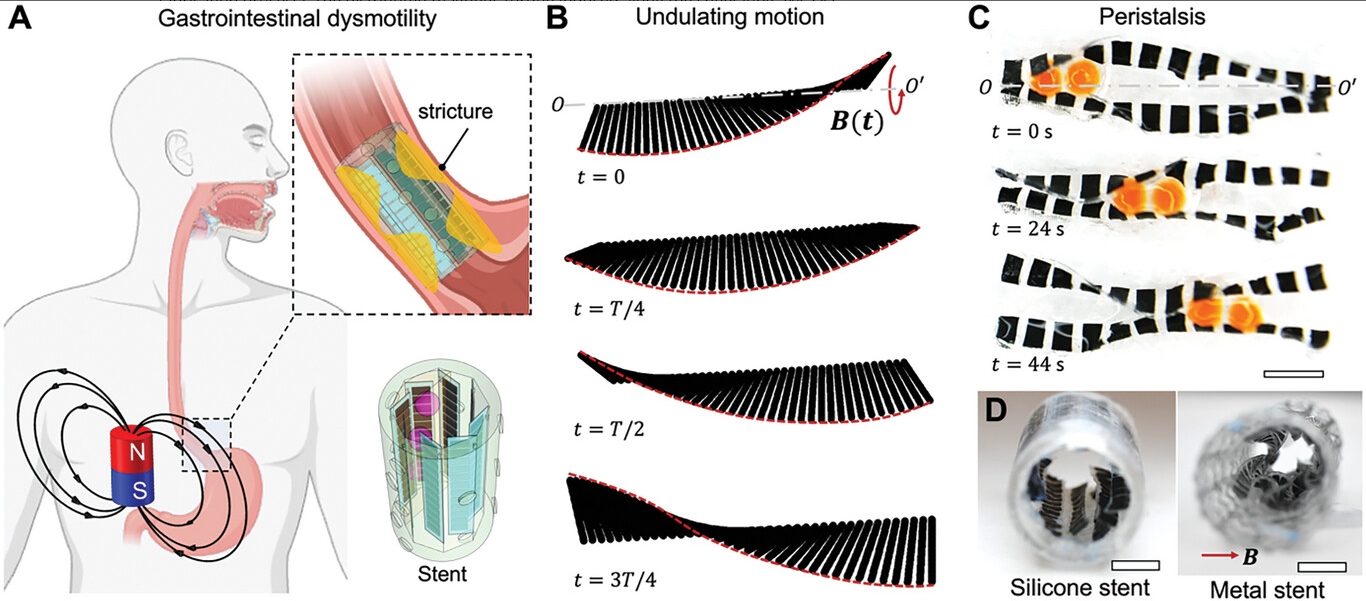
Source: Advanced Functional Materials
The movement of the “robot” is done through magnetism, commanded from outside of the body, an extra benefit for this system. This way, it does not require an internal battery system after being inserted into the patient’s body.
Such a magnetic peristalsis robot can be incorporated into an esophageal stent, replicating the movement of a biological esophagus.
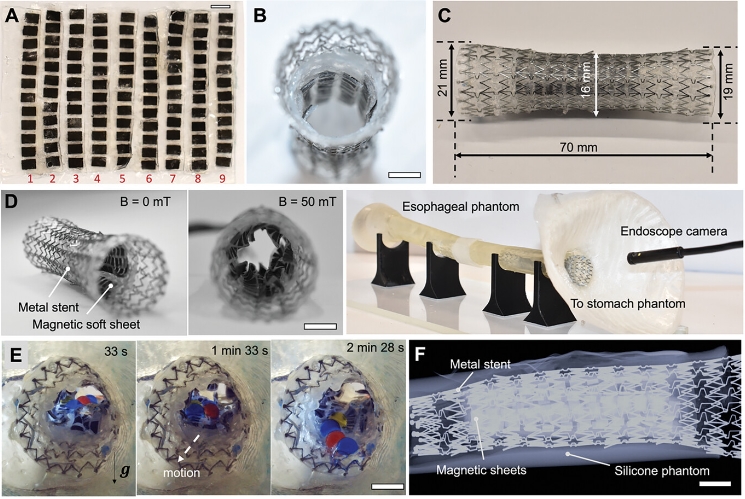
Source: Advanced Functional Materials
The manufacturing of this device took a lot of steps and trial and error to find the right method. Among other things, it took laser cutting of the material, magnetizing it, assembling it on a polyimide tape, coating it with hydrogel, and bonding it to the silicon stent (the same can also be done with a metal stent).

Source: Advanced Functional Materials
The experimental design worked well and replicated the mechanisms of peristalsis.
You can see it in action in the video below:
Future Improvements
Smaller For More Application
The magnetic soft sheet used in the prototype could be smaller, maybe by using manufacturing techniques like micro-molding.
This would allow for this design to fit into narrower parts of the body. For example, it could be used to help transport human eggs from the ovaries when muscular function in the fallopian tubes has been impaired.
The same system could be integrated into airway stents for transporting excessive mucus.
Materials
The magnetic soft sheet could have micro-patterns and coating that make the transport of liquids and solids more efficient.
The magnetic component could also be improved so that a lower magnetic field can be used (even if the magnetic intensity used in the prototype is considered very safe).
Soft Or Magnetic Robotic Stocks
1. Stereotaxis
Stereotaxis is a leader in medical telerobotics. Its Genesis RMN (Robotic Magnetic Navigation) system uses magnetic fields to guide catheters in a patient’s body. This is notably used in cardiac surgery and other endovascular treatments.
It is the only available robot in this sector, which differs from laparoscopic surgery, dominated by Intuitive Surgical (ISRG) and open surgery robots by the likes of Stryker (SYK – Mako robot) and Medtronic (MDT – Mazor robotics). We discussed these 2 companies and others in our article “Top 5 Robotic Surgery Stocks”.
This method removes the need for rigid catheters that rely on manual control and operator force, leading to higher risks of adverse events for the patients.
In addition, the traditional method for catheter implementation requires X-rays, which cause radiation exposure, especially for the medical personnel doing the procedure regularly. It is a well-known phenomenon that this can cause cancer for the doctors and nurses practicing these operations.
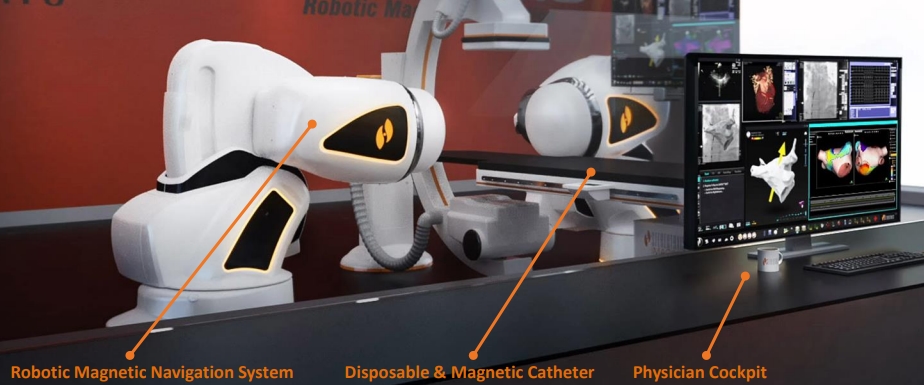
Source: Stereotaxis
The manual procedure also requires many skills, which require costly training, and will have variable success rates depending on the operator and his experience.
By contrast to the classical methods, Stereotaxis’ solution provides 72% fewer complications and 36% less radiation exposure.
The company has already deployed its system to 100+ hospitals and treated 100,000+ patients.
As Stereotaxis already uses remote magnetic navigation for surgeries, it would make sense that the company will be in a prime position to embrace the emergence of magnetic robotics.
Its reputation for safer than normal procedures using magnetic robotics could also be key in convincing medical professionals to trust the company in implementing mobile robotics in patients’ throats, reproductive systems, or airways.
2. 3D Systems Corporation
This leader of the 3D printing industry has also moved into bioprinting in 2017 with a research collaboration with United Therapeutics (UTHR). It also acquired bio-ink maker Allevia in 2021. And it announced a collaboration with CollPlant Biotechnologies (CLGN) in 2020.
This acquisition gives 3D Systems a lead ahead in the field of printing biological materials. It currently commercializes 3 models of its Allevi bioprinter.

Source: 3D Systems
As a growing producer of 3D-printed medical devices and prostheses AND a leader in bioprinting, we can imagine the company could be interested in finding new applications for remotely controlled magnetic robots in medical applications.
So, if soft robotics becomes a method to “repair” peristalsis, we can expect 3D Systems to be part of this medical revolution and help 3D print the relevant parts and tools for these new therapies.
(We explored the field of bioprinting in depth in our article “Organs On Demand: Best 3D Bioprinting Stocks”).
